
![]()

|
|
Discounted Items
Page 3
|
|
||||||
|
Working Model of an MP-38 (Item WEHR 8-3) |
||||||
| DESCRIPTION: This is a working model in every sense of the word except for the fact that it does not fire. This is a unique piece as far as we know. The collector who has consigned it says it was handmade on special German tools in a Munich machine shop. It was made to exact reduced plans for a Schmeisser machine pistol. As concerns guns and model guns this is the ultimate. Every single part is exactly like the full-sized gun. Every screw, every part, is incredibly precision milled and hand finished. Every thing that would move on the real gun moves on this miniature. The stock folds. the bolt goes back, a tiny cartridge loads and ejects. The clip removes. The trigger when pulled slams the bolt forward. This is almost unbelievable in its accuracy and overall looks and performance. It is a little gem! Nothing ever made to imitate this the most Germanic WW II weapon has ever come close to the absolute excellence of this phenomenal duplicate of the MP-38. History: The MP-38 was the first submachine gun developed by the German army since the MP-181 of World War One. Although the design has been credited to Schmeisser in many publications, it was probably designed by Erma. The first production was carried out at their plant. The MP-38 was made from 1938 to 1940 at the Erma Plant. The plastic receiver housing and aluminum frame and folding steel stock of the weapon were unique and the design of the gun had considerable influence on later submachine guns. The receiver of the MP-38 is made of steel tubing. The later MP-40 had a few variations and was popular with SS troops and was made in much larger quantities than the MP-38. Over one million MP-40's were made from 1940 to 1944. The model you see pictured here was not manufactured in millions. In fact, it is probably one of 3 or 4 at best. If Germanic precision and workmanship is your cup of tea (or schnapps) then here is something that will be admired even more than if you had the real thing.
PRICE: $3,800.00 Special sale – reduced to $1,895.00 |
|
|
||||||||||||
|
Rare Wehrmacht Portfolios of Wartime Prints (Item WEHR 7-2) |
||||||||||||
| DESCRIPTION: This is possibly one of the most important items historically that we have ever offered on this page or, for that matter, no one else has ever offered anything like it that we have ever taken notice of. This would be called a Bilderfolge or picture portfolio. It is incredibly complete with 135 beautiful, (astoundingly) beautiful prints on heavy print paper stock of the early campaigns in France, Holland, and Belgium. The title of this portfolio is "The Way of the Army Group von Küchler" in the West. It is in two separate folders-first volume and second volume. It says 68 prints per folder on count. We noticed that there might be (one print) missing or we counted wrong and perhaps they are all there. The folders are in rather rough shape, but they are at least there. However, the prints are all in 100 percent excellent + condition. General Field Marshal Georg von Küchler, Commander of the Third Army (Armee von Küchler) led his troops to victory after victory in the early warfare on the eastern front and this is the photo-documentary history of this victorious path. The pictures are phenomenal; taken by war photographers during the Third Reich. Here is the record. Here is the glory. An archival treasure chest. Here is a chance for some entrepreneur to publish this in book form. To our knowledge no one has done this with this portfolio set. The pictures seem to be unique. We have never seen any of them published before and we have purchased practically every Third Reich and Wehrmacht book published in the last 35 years or more.
PRICE: $595.00; a bargain! Special sale – reduced to $350.00 |
|
|
|||
|
Oil Painting of a German General with an India Connection (Item WEHR 6-5) |
|||
| DESCRIPTION: This particular painting is even now in the research stage and may be considered ultra-rare and very historically important. To the quick observation it may seem that we have a German general, but on deeper examination several unusual items come to the fore. One is the high collar peculiar to the WWI tunics. Also, what is seen is the 1933 date (when it was painted). Take the fact that the general is wearing the basically WWI tunic with the Nazi breast eagle would indicate that he was possibly not in the Fatherland proper when the uniform was changed. Where was he? We propose he was in India working at training Indian troops while in full cooperative efforts with Subhas Chandra Bose, who was the founder and leader of the Azad Hind (Free India) Movement. This was at that time in 1933 known as "The Indian Liberation Movement." The German chancellor, Adolf Hitler, elected in 1933, has been described as one of the most politically and geopolitically astute men of the 20th century. He had visionary powers almost beyond human comprehension. We believe that this WWI general, whoever he was, might have been immediately dispatched to India with the express duty of bringing the Azad Hind Movement into the eventual German agenda of supporting the Japanese and crippling the British forces in that part of the world. As was with many other Far East objectives in mind, the far-reaching goal was to enlist the whole of India and Japan in the necessity of the invasion of Russia and the victory over the Soviet menace. We know that Germans had worked with Bose even before this because their anti-British (Churchill) stance was as heated as the Indians in their cause. Now why do we know that this particular general was an important Indian associate in the great struggle? Look at the huge order at the neck of his tunic and lo and behold you see the early form of the Azad Hind, the order presented to Indians who offered their services to the government of the Third Reich. This was an award of the India Freedom Movement as late as 1944. Who is this general? We have the names of several members of the German General Staff, who worked alongside of Chandras Bose in these gallant efforts: Keppler, Nambiar, Werth, and Adalberft Seifrits, but the man who was directly assigned to the strict training of the Indian recruits was a lieutenant colonel name Krape. He was considered the German commander of the Indian Legion. Could he later have been promoted to general? So here we have the mystery. It is for sure that the highest order of the Azad Hind was not worn by many, if any, higher-ranking German officers. Does this narrow it down? Do you have any helpful information to add? The painting is well done of a very efficient and strict German officer (probably Prussian). There is some slight scraping at the bottom of the canvas under the adjutant cord. Otherwise, the painting is in rather good shape. With frame it measures 24 x 28 ½ inches. The actual visible painting measures 19 ½ x 23 ½ inches. The signature looks like "Emil Kase." Frame looks to be original. Well, we have a mystery, but we also have a fine historically important original canvas of a German general. We would say it is rare even in that sense and you can continue the search for the answers. To you, the challenge. PRICE: $1,200.00 Special sale – reduced to $850.00 |
|
||||||
|
SA & GERMAN SOLDIER COOKIE MOLD (Item SA 1-5; WEHR 1-2) |
||||||
| DESCRIPTION: This piece is absolutely unique and outright charming measuring 25 1/2" x 5" and 1 1/8" deep. There are two German Wehrmacht soldiers from the Army band with drum & bugle on one side, and on the other side is an SA brown-shirt trooper with "Heil Hitler" salute and, below, a soldier standing with rifle at parade rest. This is typical Tyrolian-style carving. There are a few wormholes, but all in all, quite good condition.
PRICE: $600.00 Special sale – reduced to $375.00 |
|
|
|
Model 1855 U.S. Percussion Pistol-Carbine (Item ANTWEP 1-4; USARTICLES 2-31) |
|
DESCRIPTION: This is one of the most interesting American arms of the 19th century. The model 1855 was an interesting hybrid sporting a 12-inch 58-cal. rifled barrel and as a pistol had all the "grace and manageability of an anvil." It had a Maynard tape primer system. Patented by Dr. Edward Maynard in 1845. The M. 1855 had a full-length stock, brass furniture, and a carbine-style swivel ramrod. More importantly it was issued with a detachable, brass-mounted butt stock also, that it could be employed as a carbine. To economy-minded ordnance officials that seemed to be a dream come true—two arms for one! What could be better? The pistol sans the butt stock is 17 ¾ inches long and weighs a muzzle heavy four pounds, 2 ounces as opposed to the M. 1843, which had an overall length of 14 inches and weighed a pound less. All in all, it looked like a pretty tidy package, one for which then Secretary of War, Jefferson Davis, felt would be just the ticket for both Dragoons and Cavalry. Unfortunately, the troopers didn’t agree as some design flaws appeared. The Maynard tape primer was deemed less than reliable by most who tried it and a major concern was the claw-type butt stock attachment which was not particularly effective. Future Confederate General, Richard Ewell, evaluated the arm in 1858 and found that the wobbly butt-to-pistol fit was detrimental to good accuracy. Cavalrymen were issued with a set of pommel holsters, one for the pistol and one for the stock; a very rare accoutrement today. Slightly more than 4,000 Mod 1855s were manufactured between 1855 and 1857 and issued to units in the west where they were found to be at least serviceable. With the onset of the Civil War the pistol-carbine was given a new lease on life and many were carried by regulars and state troops, north and south, and photographs that show troopers with Model 1855s and the worn condition of surviving specimens seem to indicate considerable usage –at least in the early months of the war. One can assume that as better arms became available, the 1855 was eventually returned to stores, though it is possible that arms-hungry rebels held onto them longer than did their Yankee counterparts. One thing that cannot be denied is the novelty of the piece. It was the only pistol of its type to ever be issued as primary standard to American troops and while it might not have been highly valued during its service lifetime, today it is one of the most sought-after collector firearms imaginable. It only took 158 years to come into its own. The pistol we offer is in beautiful condition. We think there is a possibility that the pistol is a prototype. It is exactly as described throughout many either offered or researched on the internet, but there are a few notable exceptions. First, the pistol grip unlike others seen on the web is finely checkered. This could have been accomplished after issue, but we doubt it. It looks factory to us. There is no date on the lock plate as seen on others. Model 1855 pistol-carbines were not serialized, but confusingly carried assembly numbers stamped on the lower rear of the pistol butt cap and lower tang of the butt stock pretty much always with these two parts. The one we offer has neither. The butt stock fits loose and shaky but the National Firearms Museum that is associated with the NRA describes this phenomenon, thusly: “One problem with this firearm was a tendency of the stock attachment to loosen after use.” This was often problematical to drawing a good aim with the gun because the weapon was not stable in many cases. The only marking is “VP” where the barrel meets the wood. Everything about this pistol seems to say “I am a rare prototype!” There are several copies available on the web of this pistol and stock, but this is definitely not one of them. The gun is very obviously genuine and of the period. The wood on the pistol stock matches very closely the wood on the pistol. I believe this is a very rare and highly desirable piece of American history. It's interesting that the May 1993 edition of the prestigious Deutsches Waffen-Journal featured on its cover this 1855 pistol-carbine along with a six-page article. They called it one of the most unique weapons America had produced, up to that time. They heaped praise on it and called it a precious and rare collectable.
PRICE: $7,500.00; Special sale: now marked down to $6,500.00 |
|
||||||||||||||||||||||||
|
Huge Book on Spies & Espionage, 1931 (Item GEN 8-7; KBOOKS 2-3) |
||||||||||||||||||||||||
| DESCRIPTION: This book is huge; 12 x 9 ½ inches and over 2 inches thick. There are hundreds of pages of text and pictures. The book is very rare; published in Munich by the Justin Mofer Verlag in 1931 and the information comes from Office of Publication of the War and Military Section of the Reich’s official archive. There are 687 pages. This is the most concise and complete work on spies that exists in the world archives; very seldom encountered, especially in this wonderful condition. The opening flyleaf page is loose, but there! This is a must for any collector of espionage material or general WWI. Police collectors will also appreciate this book. Much of the pictures are of executions of spies and the many smuggling and concealment devices that these daring people used. The is a treasure of archival information and a gallery of rare pictures.
PRICE: $495.00; Special reduced price to $250.00 |
|
|||||||||||||||||
|
Set of Cigarette Case and Watch Fob for a German Cavalry Officer (Unique!) (Item WEHR 33-22) |
|||||||||||||||||
| DESCRIPTION:
Here is a great matched set of watch fob and cigarette case that are both beautifully engraved and probably a presentation to a cavalry officer who evidently served in the Kaiser’s Imperial Cavalry Corps in WWI, or even possibly the Franco-Prussian War. The items seem to have been presented by comrades of the officer corps that he served with. Both on the watch fob and the case is this notation: “Gew.v. Uffz. Korps 3.Esk. M.U.P.D. Hilg. 11.10.34.” “Gew.v.” means “Served with #5.” “Uffz. Korps” means “Officer Corps.” “3.Esk.” means “Third Squadron.” “Eskadron” was a cavalry unit first named thusly in the army of Frederick the Great and used throughout the First World War. The letters “M.U.P.D. Hilg.” are unrecognized. “11.10.34” is the date of presentation. Actually, in 1926, there was a German silent war film that played by the name “Die Dritte Eskadron” (“The Third Squadron”). Actually, the Third Squadron was the famed Prussian Garde Kurassier Regiment. Today the word “Eskadron” is often used in conjunction with riding boots and horseshoes. Of course this has direct historical reference to the German cavalry regiments that carried that name. The Articles The cigarette case is in excellent condition and it measures 3 ½ x 3 inches. It has the joined initials that look like “J.M.C.” In the upper-left corner is an applied horse’s head with tack. On the back of the case are the words of presentation. The watch fob also has the horsehead on the largest of the silver bars and on the bottom bar, you can see the tiny swastika indicating the veteran was an N.S. patriot. On the middle bar on the back you can again see the same inscription that is on the cigarette case. The fabric of the fob is shown as the German national colors as brought back by the National Socialists in the name of German patriotism. The fact that these two items are still together after 80 some years is incredible! This is a beautiful and prodigiously rare set of beautiful military relics from the better age. “Wohlauf Kameraden! Aufs Pferd, aufs Pferd!” PRICE: SOLD |
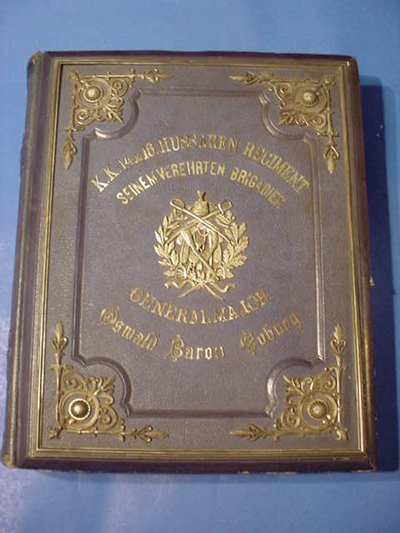 |
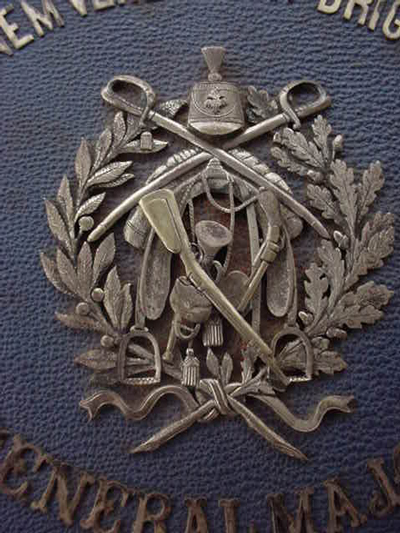 |
Beautiful Presentation Album of Photos from the 14th and 16th KK Hussar Regiment of Imperial Austria (Item IMP 1-1 & KSPEC 1-3 & WWI 12-10) |
DESCRIPTION: This is a gorgeous photo album presented by the elite 14th and 16th Hussar Regiment to their Brigade Commander, Major General Baron Oswald Coburg (probably a retirement gift). In the center of the front cover is a wonderful badge style escutcheon that employs all the equipment of the horse solders (Hussars) -- carbine, swords, shako, horse stirrups, revolver, bugle, etc. and all of this is surrounded by branches of palms and another of oak leaves. This is all in the finest of 800 silver. At top and bottom are the words of presentation. The corners are highly decorated with beautiful floral designs in high relief. The cover is in lovely blue leather. The album measures 13 x 10 inches and is slightly over 2 inches deep and contains 77 mounted picture all on the studio card stock of the age; there are also two loose pictures but all the photo slots that are made to contain the images are filled. The pictures range in two sizes 2 ½ x 4 1/8th. And the bigger ones are 5 ½ x 4 ½. All are in perfect shape and the pages are clean. The Germanic phrase in the title of the albums cover KK stands for Kaiserlich and Koniglish (Imperial and Royal). This was applied to all units that served Austria and the Hapsburg monarchy. The album is in great shape throughout. The pictures of the uniformed Hussars show the dashing and daring of these soldiers of the horse. The Hussars were of course light cavalry which first originated in Hungary and of all the world's Hussars, the Austro-Hungarian riders were the best! They were very effective against the Prussians and French. The Allies in WWI and even against the Russians in the early days of WW II. This album miraculously turned up and bears silent testimony to a band of equestrian heroes who shall never be forgotten in the annals of military history and glorious renown. PRICE: $1,600.00; Special sale: consigner reduced it to $950.00 |
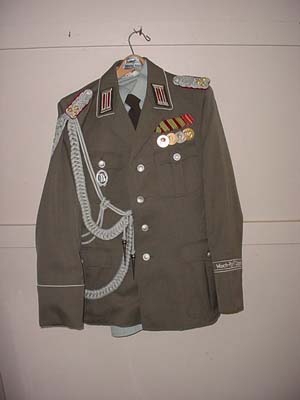 |
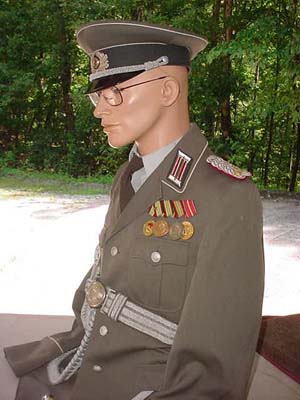 |
Complete Uniform of the Combat Force of the "Stasi" (Item DDR 1-1) |
DESCRIPTION: The mission of the dreaded "Stasi" was to protect the East German communist state from penetration by foreign intelligence services, to root out domestic traitors of the DDR, to provide security for government buildings and personnel, to execute special military operations including overseas and to provide the Stasi with a combat arm similar to that of a motorized rifle regiment. This was the "Wacht Rgt. F Dzierzynski" whoe mission it was to provide the Stasi with a reliable combat force under its own command. Organization: Expanded regiment numbering about 10,000 elite guard troops, the unit had at its disposal the same type of weapons as a motorized refle regiment: assual rifles, artillery, anti-aircraft guns, armored personnel carriers and helicopters. Their uniform consisted of stone gray tunic and bloused jophers for officers. This outfit we offer is the most complete one we have ever seen -- offered with cap, tunic, shirt, agulette, dress belt, dagger and hanger straps for dagger. On the breast are four heo medals and on the other side pocket is the DDR sport badge in silver. One of the medals (last one with red ribbon) is the Treue Dienst medal (Faithful Service). Actually, all are for true service in various grades. This guy was a real dedicated communist 1st Class! This is a very rare grouping from a very elite unit of the DDR and the man was an Oberst (Colonel), a high rank in special elite forces like this. The uniform is in great, 100% condition throughout. We may not see one like this again. Spectacular. PRICE: $1,350.00 High for a DDR uniform? Certainly NOT high for this one! Discounted again now to the incredibly low price of $999.00 for the whole ensemble. This is a super bargain!!! |
| ||||||||||||||
|
Book München vom Wesen Einer Deutschen Stadt, Hauptstadt der Bewegung (Item GEN 10-16; RAREBOOK 2-11) |
||||||||||||||
| DESCRIPTION: The book Saga of the Nature of a City, Head City of the Movement has a print cover with a statement that seems to translate to something like: “To say it cannot be done is not the German way!” This book sums up in words and pictures the spirit of this the greatest, most fun-loving, art-appreciating, and spiritual city of Europe. Especially in the Third Reich Munich showed its deep inner spirit. But to the NSDAP and its leader, Adolf Hitler, Munich was the inner soul of the German nation. Berlin was the nation’s capital city, but Munich was the heart and spirit of the National Socialist Bewegung (movement). It was there that the NSDSAP was born. It was there that the Putschists of November 9, 1923, laid down their lives at the Feldherrenhalle. Old Munich is reflected in the gorgeous architecture of the past: churches, palaces, stately castles, and mansions abound and contrast with the new NSDAP buildings that meet in happy union with the glorious past. Buildings by Troost and Speer grace the gorgeous Haupstadt. Featured is the grand parade to open Paul Ludwig Troost’s House of German Art. The parade was the greatest culture lineup the world had even seen. Two thousand years of Germanic art and culture with floats, actors, reenactors, etc. Much of the book is dedicated to German art, old and new. Very unfortunately four of the finest of the picture pages were stuck together at some point during the past 70 years, and dime-sized scars are the result (they would be on the Third Reich’s most important buildings in the Königsplatz) Interestingly enough the captions under the great pictures are in German, Italian, French, and English. The book was published in 1937 and has 133 pages of text and superb pictures, photos, and drawings—culture, culture, and more culture! It measures 8 1/2 x 11 1/2 inches and other than the slight damage to those four pages, the book is in wonderful shape.
PRICE: $225.00; Special reduction sale now $150.00 |
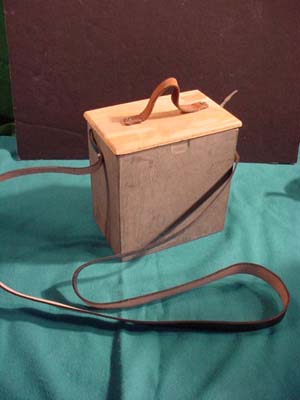 |
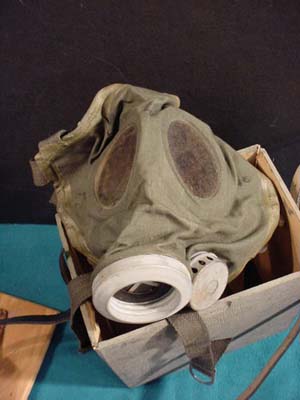 |
German Civilian Gas Mask for a Child (Item GEN 14-10) |
| DESCRIPTION:
This is an issue gas mask with wooden carry case.
After the German people and their N.S. government saw and realized that the British and Americans were not just bombing military and industrial complexes but these allies of Red Russia had now seen that the war was nearly over and now it was time to murder as many innocent civilians as would be possible. In accordance with the Morgenthau plan, the firestorm that was visited upon Dresden by British and American bombers accounted for roughly 202,400 dead -- 3,900 tons of high explosives and incendiaries dropped by 1,300 bombers destroyed the most beautiful baroque city in Europe. Germany was already on its knees. So what could the reason be to do this horrible thing? This was truly a war crime personified, and basically was an exhibition of warning to the Russians that were now perceived as the enemies of tomorrow! (*editor’s note) I, Paul at Germania, sincerely hope that bomber Harris the Monster who chose Dresden as the main target for murder is even now walking the hot coals down there.When the British Queen visited Dresden (an amazing bit of cheek) in 2004, she was pelted with eggs because she refused to even offer an apology for the WWII murder rampage. As to this child’s gas mask, it is one of the results of the Dresden bombing. When the N.S. government saw with abject horror what the allies were capable of (outright murder of civilians), ttey thought that these enemies might next unleash gas warfare as the next exercise in horrific slaughter of the German population. Most of the German factories were bombed out of existence -- even the firms that produced gas masks but they had to manage to produce some precautionary devise to protect adults and the precious little children from the horrible gas attack that they felt was next on the Devil's Agenda. They undoubtedly were right.
Gas warfare would have come forth had Germany not surrendered and I am positive that Berlin, Munich, Hamburg would have been the chosen places for a nuclear holocaust instead of or in addition to the Hiroshima cataclysm! This was also a warning to the Russians (it was only that!). The gas mask seems to be effective even though manufactured so late.
The box with carry strap is truly crude, the best that they could do at that stage.
The mask is definitely a child size and has all its various elements. It has the issue eagle and swastika stamp to the side, very faded but there! The mask case and all parts are in remarkably good shape. Not pretty at all and the reason for its issue was not a rosy picture either. Man's inhumanity to man, women and children was illustrated here and should be remembered for all time with disgust and indignation. Remember the victors of a war write the history of their participation in war and unfortunately they write the history of the vanquished as well. Do you think the people of Dresden would get a fair hearing today? I doubted it up to now. But presently revisionist history is starting to tumble the house of cards containing all the lies and distortions perpetrated by the ‘glorious Allies’ and their crusade for Democracy. Perhaps this little child’s gas mask can be considered a token of remembrance of this crusade of fratricidal war. PRICE: $375.00 Very rare in this form; Special sale; reduced to $235.00 |
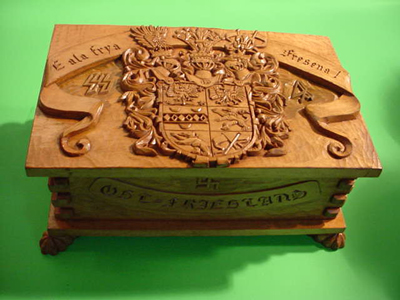 |
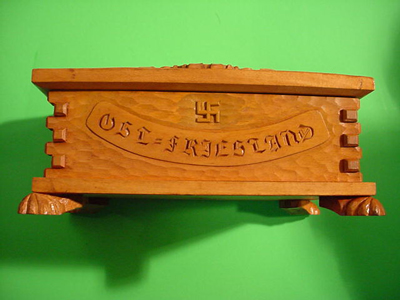 |
Carved Box from Ost Friesland (Item GEN 14-12 & ART 16-8) |
DESCRIPTION: This beautiful hand carved wooden box is from east Frisia in Northern Germany. The motto on the top of the box over the Frisian Coat of Arms is interpreted as “Stand Up Free Frisians.” According to 16th century sources it was first spoken at the “Upstalsborn” in Aurich where Frisian Judges met during Pentecost and is traditionally answered with “lever dood as Slav” or in English rather dead than slaves. Tthe motto refers to the legendary “Frisian Freedom,” a right to accept no rule besides that which comes from the Holy Roman Emperor and the Christian God! In 1933 however the Frisians still obeyed their God but now the Emperor was replaced by Adolf Hitler who they adored and of course their motto stayed the same. This box was owned by a loyal NSDAP member who serve in the SA Standarte commanded by Anton Bleeker in Aurich in Oldenburg Ostfriesland. He was as his family relates involved in the raids against the ritual slaughter establishments in Aurich, all the “Schachtmesser” establishments named after the killing knife were all were burned to the ground. This was orchestrated on the orders of the Gauleiter Karl Rover later this man was transferred to the SS and served as a guard at the Sachsenhausen concentration camp. The box was according to his family used to store his letters that he received while a guard at the camp and some pins and awards he received while in the SA and SS. The family for personal reasons retained all of this and destroyed some of it for fear of post war edicts. The measurement is 9 ½ inches long across the top, 6 inches wide and 4 inches deep. Besides the beautiful Coat of Arms on the top, the front panel has a scroll with Ost Friesland under a swastika. The box is beautifully dovetailed with decorative feet underneath. The carved SS and SA symbols are carved as a matter of his intense pride of membership in both organizations. The carving was accomplished by a master and of course the historical importance is obvious. It was hidden away for 65 years and only recently did members of the family decide to sell it. The intense pride of their ancestor was long gone among these modern reeducated Slav’s and they made a decision that perhaps it was better to be a slave than to stand up for those old Friesian values in this “New World Order” generation! PRICE: SOLD |
| |||||
|
Hunting Scene in the Medieval Motif (Item HUNT 5-7; OLD 4-4) |
|||||
| DESCRIPTION: Here is a positively great item for inclusion in any serious German Teutonic hunting collection or collection of true Germanic antiquities. This is a true museum piece personified! It depicts a hunter on horseback, who, with his dog, runs down a stag. This presentation was produced using the art of marquetry; the craft of making pictures from wood veneers. There are similar pieces in the fine German museums such as the Jagdmuseum in Munich. The piece is 33 inches by 19 inches. The hand-carved frame is crafted with true inlay; a very difficult process requiring the truly skilled hand of a master. We feel that this magnificent piece may be from the late 18th or early 19th century. Simply wonderful for a fine and advanced hunting collection or for the of collector museum-grade Germanic relics.
PRICE: $1,800.00; a museum treasure; Sale: Consigner has decided to reduce the price of this piece to $900.00 |
|
|||||||||||||
|
Cased Goethe Medal for the Arts and Science (Item NSD 12-22) |
|||||||||||||
| DESCRIPTION: This is the “big” one. It’s considered the most prestigious and rare of all German awards almost without exception. The Goethe Medaille für Kunst und Wissenschaft was founded in 1932 to reward outstanding service during the Goethe centennial. It was initially intended to be a one-time award, but President Hindenburg retained it as a national award and this practice was continued by Hitler. The medallion is in genuine silver measuring 2 3/4 inches in diameter and has the profile of Goethe on the obverse and the name “Goethe” on the right. On the reverse is the stylized national eagle over the inscription “Für Kunst und Wissenschaft,” “For Art and Science.” Engraved around the outer edge is the inscription that translates to: “Founded by Reich President von Hindenburg 1932.” The Berlin sculptor Hanisch-Concee was responsible for the design of the medallion and his signature is found immediately under the neck of Goethe. The earlier-produced medals like this one have the recipient’s name engraved in large, block letters around the edge. The proof mark unfortunately is not clear. All that had to happen is that the strike was not strong enough and this is the result on coins, guns, etc., but the ‘835 PR ST. MB’ is there and can be perceived under magnification. This stands for the ‘835’ silver designation and the Prussian State Mint. The Goethe Medal continued to be awarded even after the introduction of the German National Prize for Art and Science in 1937. As of January 1943, a total of 467 had been awarded. The medallion is contained in a blue, simulated-leather hinged case with blue-velvet base interior. On the top of the case’s lid is an absolutely gorgeous national eagle heavily embossed in gold on the pebbled-finish case. The recipient was Friedrich Stahl and of course this is the name engraved along the edge. These medals were invariably personally presented by Adolf Hitler, himself, at a very grandiose ceremony and it certainly was the most respected civil award of the Reich next to the Eagle Shield of Germany and the National Prize for the Arts and Sciences, which was a replacement for the Nobel Prize since he had forbidden German citizens to accept the international prize. That medal encrusted with diamonds was of course the most coveted prize of all, but don’t sell this one short; the prestige of receiving the Goethe prize was extremely respected. Now, for the recipient of this Goethe Medal; the medal was presented personally by Adolf Hitler to Friedrich Stahl, who was likely the favorite artist of the Führer. The following is an excerpt depicting Stahl’s adult life: He was born on 27 December 1863, at Munich. He studied at the Munich Academy and Berlin and had a brief stay in England in 1900. Exhibits were already showing up in 1901 at Schulte's in Berlin. After living in Italy, mainly in Florence, between 1904 and 1913, he began working afterwards at Feldafing (Wiirmsee) for 12 years, then returned to Italy in 1925 and decided to settle in Rome for good. He had exhibits in 1919 at the Crystal Palace in Munich. He was a painter and illustrator inspired by the Mediterranean world, and was also influenced by Feuerbach and Bocklin, by the painting of the Italian Renaissance and in particular by the English Pre-Raphaelites. Stahl painted portraits, landscapes, groups, still lifes, flowers, allegorical and mythological compositions. Hitler, who was especially fond of him, bought 20 of his paintings after 1933. Stahl exhibited eight canvases at the GDK in 1937-38. In 1939, became a member of the Deutsche Kunstgesellschatt and of the Prussian Academy of Plastic and Graphic Arts. The same year, at the same time under the auspices of the Kaiser-Wilhelm-Institut in Rome and the Rosenberg agency, he exhibited at the Zuccari Palace in Rome (the Italian Minister Giuseppe Bottai attended the inauguration) and at the Kiinstlerhaus in Berlin. (This was his first exhibition in Germany since 1919). In April 1940, Stahl received the Goethe Medal at the proposal of the director of the Kaiser-Wilhelm-Institut in Rome, Werner Hoppenstedt, supported by Martin Bormann, who points out that the artist's state of health demands an urgent decision. The medal is presented by the German Ambassador in Rome, Hans Georg von Mackensen, at the command of Goebbels and Hitler. Stahl died on 12 July 1940, in Rome. He is buried in Rome in the cemetery close to the pyramid of Cestius. The tombstone, a work of the sculptor Walter Rossler, is done at the personal command of Hitler. A special exhibition in his honor, with 67 of his works (oils, watercolors, drawings) was immediately organized the same year on the fringe of the GDK. Then we show a few of Stahl’s many paintings. He was certainly deserving of this auspicious award. The medal and the case it reposes on are both in perfect order and condition. It is a real pleasure and we are prodigiously proud to be able to offer this wonderful extremely important award with connection not only to this very great master, but the connection to Unser Hitler, as well. We have many important pieces on Germania and many are more costly than this one, but we would be hard pressed to ever say that any of them would be more important. PRICE: $5,900.00 Special sale now offered at $4,950.00; a fantastic bargain! |
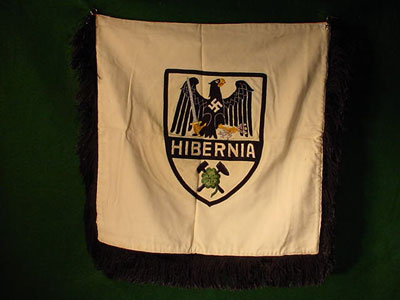 |
 |
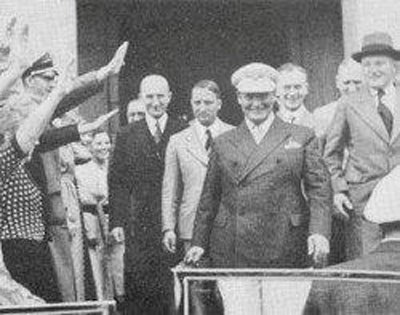 |
20. 20. Juli 1939: Hermann Göring vor der Hauptverwaltung der Hibernia AG in Herne Hermann Goring in front of the headquarters of the Hibernia Herne AG: July 1939 |
| Zechenzeitung: Hermann Göring besichtigt das Hydrierwerk Scholven "Hermann Göring ist da! ... Jedenfalls stand am 20. Juli 1939 morgens gegen 11.30 Uhr Hermann Göring unerwartet vor unserer Hauptverwaltung. Er hatte gelegentlich bei seiner Fahrt über die Wasserstraßen Deutschlands im Rhein Herne Kanal mit seiner Jacht "Karin II" Station gemacht. Es ist verständlich, dass der Besuch des Generalfeldmarschalls wie ein Alarm durch die ganze Verwaltung lief und einige hundert Menschen wie einen Bienenschwarm durcheinander brachte. ... Von Herne aus ging dann, einem Wunsch des Generalfeldmarschalls entsprechend, die Fahrt weiter zum Hydrierwerk Scholven. Hermann Göring besichtigte mit großem Interesse dieses im Rahmen seines Vierjahresplanes neu entstandene Werk und äußerte seine lebhafte Befriedigung über den hohen Stand der Produktionsentwicklung..." Mine newspaper: Hermann Goering visited the hydrogenation Scholven |
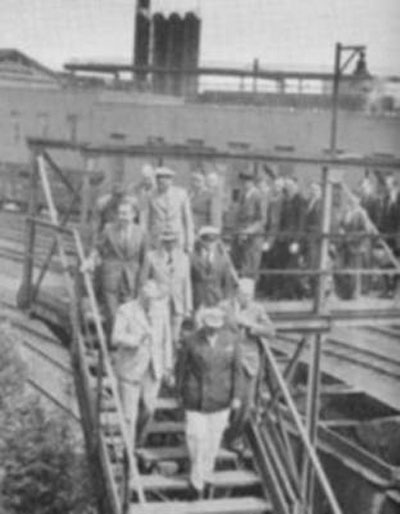 |
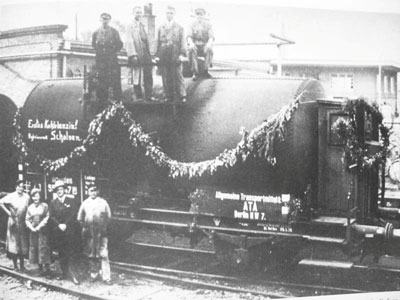 |
Image: Gelsenkirchen stories. Scholven 1936, erste Lieferung synthetischen Benzins aus Steinkohle Scholven 1936, first delivery of synthetic gasoline from coal |
| Bild: Hibernia Zeitung, Poster 1937 Das Poster in DIN A4-Format aus der Zechenzeitung der Hibernia zeigt ein Jagdflugzeug der deutschen Wehrmacht. Im Bildrand unten links befindet sich das Wappen der Hibernia, welches zur Zeit des Nationalsozialismus unterhalb des Hibernia-Schriftzugs das durch ein vierblättriges Kleeblatt ergänzte Symbol Schlägel und Eisen zeigt und oberhalb den preußischen Reichsadler mit einem Hakenkreuz auf der Brust, in der rechten Kralle ein Schwert haltend, mit der linken Blitze schleudernd. Image: Hibernia newspaper, poster 1937 |
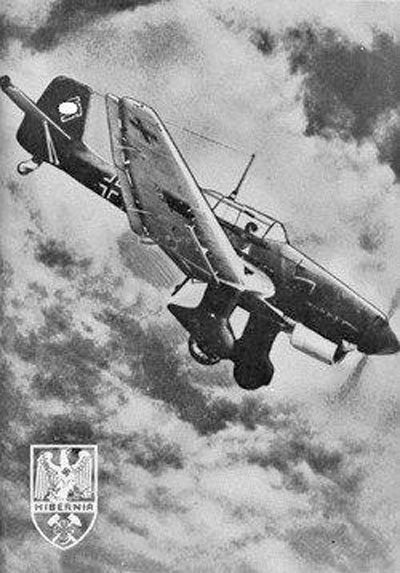 |
Wonderful Bugle Banner of the Hibernia Zeche Kameradschaft (Item FLAG 3-3) |
DESCRIPTION: Here is possibly the most beautiful, most rare, most interesting item of vast historical interest that we have ever handled. This banner is from a brass band that was formed in the area of Scholven. Here was found the vast and massive plan for the conversion of coal into gasoline. Had it succeeded and somehow escaped the night and day bombing runs made by the enemy (England and America), the outcome of the war might have been far different! The hydrogenation Scholven was purely a military operation. The fuel supply was meant exclusively for military purposes, however, as early as 1933 Hitler had announced in February that under his four year recovery plan public measures would serve to create jobs and the militarization would make Germany ready for war because he knew that Britain and France were looking menacingly at Germany to say nothing of the great danger that loomed in the Communist East. So with the placement of this four year plan to have Germany's people working again and to supplant an awareness in the people for the possibility of war, Hermann Goring is appointed as the Tsar of the great social and military venture. Gorings’ task in the context of this plan was to align the companies of the Reich and if necessary there would be government intervention in all production process within the agenda of the National Socialist economic policy in peace or war. Germany wanted to also be self-sufficient, completely independent of foreign supplies of raw materials. A most difficult task when one considers that at that time potash, lignite and coal were in insufficient quantity and crude oil was scarce so this led to the construction of hydrogenation Scholven in 1935 and the mining company Recklinghausen and mining company, Hibernia, are now subsidized and nationalized. For traditional reasons, the Hibernia Company keeps the name Hibernia A.G. (more lately). The goal of the four year plan is to use 10% of the coal for the experimentation in the methods of converting coal to petrol (gas). In July 1936., for the first time the Hibernia AG Co. has success in the production of gasoline from coal tar, three weeks later directly from coal. Hibernia decided after this pioneering achievement to actually make the first hydrogen production plant for the process. They are no longer just a mine they are now a full- fledged plant producing synthetic gasoline from coal. In 1938 the ministry of hydrogenation Hermann Goring instructs the plant to switch the production of 200,000 tons of gasoline for autos and trucks to 180,000 tons of jet fuel. So important was the Hibernia plant that at this point an entire huge community of workers with government supplied housing was established and social events were planned and acted upon by happy workers. The symbol or logo of Hibernia was the Prussian eagle holding in his right claw a sword and in his left, lightning flashes. In the center of his chest is seen the swastika of the Reich and under the eagle is a black scroll with the name Hibernia! -- under this you will see a four leaf clover or shamrock, placed upon the crossed hammer and chisel that has been the traditional logo of German miners for centuries. The mining community had its own local newspaper and in 1937 a poster that hung in plant work places, offices and workers mess halls showed a JU-88 Stuka dive bomber that has this Hibernia symbol shown on it. Reichsmarshall Goring made quite a few official visits to all the hydrogenation plants and especially Hibernia. He expressed his lively satisfaction at the high level of production development that had been reached there. Wherever Goring went, extremely jubilant people gathered to greet him while chanting Unser Hermann -- Our Hermann. Hibernia and the other mining communities in the Scholven Gelsenkirchen area were as patriotic National Socialists as could be found in the Reich. In 1932 nearly 40,000 people were out of work in the economic crisis, in 1939 the employment offices of the city reported only 100 people unemployed. The industrial companies complained of a labor shortage; the people had good cause to be thankful to the National Socialist Party and especially the four year plan manager Goring. Every National Socialist event in the N.S. calendar was ceremoniously honored and celebrated to the absolutely fullest extent. The Fuhrer’s Birthday, the observance of the Putsch in Munich, and the Machtergreifung ascension to power by the National Socialists party. There was a sharply dressed musical band who played the Horst Wessel Leid to symphonic excellence and that is where our bugle banner comes in -- but first let’s look at the first origins of the name Hibernia and its use in N.S. Germany. The name of course is the classical Latin name for the Emerald island of Ireland. But how does it come to be used in Germany? Did you ever hear of the expression “Coal to New Castle”? The Irish who wanted to invest refused to invest in the English coal industry in the 1800’s because to the patriotic Irish, England was the ‘traditional enemy’ so they looked east and since there was always a great predilection between the Irish and the Germans, several Irish entrepreneurs decided to actually sink shafts in the Gelsenkirchen area and there were two other mines besides Hibernia...the Shamrock and the Erin...and by 1800 they were united under the name Hibernia. The first man to actually open those mines was a Victorian Irish gentleman by the name of William T. Mulvany 1801-1885. We mentioned earlier that it was by tradition a word scared to Germans (real Germans) that the Hibernia name was preserved even in the Nationalization of the industry. And this tradition is surely the reason the shamrock was made part of the N.S. banner and probably myriad other objects. The banner is double sided with the eagle and shamrock on one side and the other side has the swastika on white circle with red background. The eagle is absolutely gorgeous with the sword and lightning bolts in silver bullion. All around the side edges and bottom you can see the black fringe. This white field with black is typical as the colors of Prussia and Gelsenkirchen was and is the German state of Prussia. The banner with the fringe is about 20 inches across and 18 inches high; the quality is absolutely remarkable, so here we offer a thing of obvious beauty but because of its connections to an industry that, if it succeeded, could have won the war for Germany. It is of remarkable and of eminent importance. PRICE: $8,500.00; Special reduced offering on the absolute, most-important banner ever offered on the web. Now offered for $4,500.00 (Incredible!!!) |
|
||||||||||||||||||||||
|
Seven Villeroy & Boch Mettlach Plates Depicting German Soldiers (Item KSTEIN 2-12; KGLASS 3-16) |
||||||||||||||||||||||
| DESCRIPTION: Here is a fantastic grouping of plates by the famed Villeroy & Boch firm located in Mettlach, Germany. This is the revered manufacturer of the finest of ceramics and porcelain. Collectors please note the similarity between the Mettlach military theme beer steins (the series) and note that these plates are virtually identical in color and style. Although the stein series is rare, it is found much more often than the plate series. They are truly scarce even in the professional circles of Mettlach collectors.
Ever since they were first produced in about 1850 Mettlach steins and chargers, plates, and other ceramic items have been cherished as very-high-quality art objects. The group of seven plates we have to offer according to the man we bought them from has provided us with the following information. He said his mother-in-law, Elizabeth Keller, gave him the plates in 1966 and at the time told him that her mother, Elizabeth Bernhard, was working as a truly loved and highly appreciated servant at the baronial estate of Count von Helldorf in Wiesbaden, Germany. Elizabeth Bernhard received the plates from Count v. Helldorf as a wedding present when she married August Enders on July 6, 1901, in Wiesbaden. Interesting is the possibility that this count von Hellddorf of Wiesbaden may very well be the father or grandfather of Wolf Heinrich Graf von Helldorf, president of the police in Potsdam and Berlin. Born a nobleman’s son in Merseburg, he was a member of the Reichstag 1933-1944. Unfortunately, he was involved in the 1944 plot to kill Adolf Hitler and was executed by hanging in 1944 at Plotzensee Prison. We cannot definitely attest to the relationship, but it looks very possible. I hope the elder Graf von Helldorf fared better and was a true German patriot. The Plates There are seven of them all in perfect condition. Only one of them features the full Mettlach markings with the winged angel face hovering over the Villeroy & Boch geared logo. The rest of them have numbers and letters example (737 Geschutz and a large F, A, K, J, etc.) but anybody can see that they all are from the same Mettlach series. Each one depicts a different epoch of German military history and each has an individual title running over half the front diameter and each soldier is identified below the image. They are depicted in periods from the time of Frederick the First to the Franco-Prussian War of the 1870s, and here they stop since they were presented as the wedding gift in 1901; so they date well before the First World War. They are well over 100 years old and to still be in this condition is remarkable, but goes to prove my earlier statement about being cherished! These are a worthy treasure to grace any good collection of Mettlach steins or a notable Imperial German collection. PRICE: $1,225.00; that’s about $175 each for plates that individually could sell for about $350 each, or more. Serious collectors should move quickly on these! We are offering these magnificent pieces at a very special discount. All for $880.00. |
| |||||||||||||||||||
|
Kaiser Wilhelm II Dinnerware (Item WILHELM 3-7) |
|||||||||||||||||||
| DESCRIPTION: This is a grouping of Besteck flatware directly from the gala dinner table of Kaiser Wilhelm II in the Potsdam palace. This is in absolutely beautiful condition in fine 800 genuine silver. We are offering three pieces at a time (we have six). This is probably the most elegant design ever used by a ruling monarch. It’s very heavy and bold clearly marked with the moon crown and a logo. They are also marked with the company name of this firm that was granted the royal permission to be the exclusive supplier of this Kaiseruchebesteck. This firm was Gebruder (brothers) Friedlander and this appears on the forks right below the tangs. On the back side of the grip or top is the Prussian crown over the Wilhelm (WR), while the front side bears the Prussian Imperial eagle. Both extrusions are surrounded with fine flora representation that adorns the entire implement. Again, these are almost twice as heavy as other royal or aristocracy items of a similar nature. The items are in beautiful condition. The blade of the knife is slightly pitted (maybe more than slightly) as would be expected in a household item used on a daily basis. Make no mistake, these are from the Kaiser’s own set, and the fact that he actually used them is to be taken for granted. These are probably well over 100 years old from an illustrious and beautiful era. To hold one has almost a magical mental transformation to that time of grace and glory. The knife is 11 inches long, altogether. The blade is about 7 inches long with almost 1 inch wide at the center. The dinner fork is about 8 ½ inches long and the fork blade is about 1 ¼ inches wide. The luncheon fork is 8 inches long with a measurement of 1 inch at the blade portion. The price stated is for three pieces-knife, dinner fork, and luncheon fork. This is a unique opportunity to own a fantastic, historically important piece of the memorable Kaiserreich era.
PRICE: $2,400.00 SALE - - This magnificent Kaiser set is now specially offered at the reduced price of $1,800.00 |
|
|
|
Model 1936 Chained SS Officer’s Dagger; Second Type with Anodized Scabbard (Item SSDAG 1-11; SS 36-13a) |
|
DESCRIPTION: Here it is collectors; an affordable, nice example of the ultimate National Socialist item: the collector’s dream! What is more typical of the N.S. regime than this dagger? When the chained SS dagger is shown all eyes open wide! There is something about this art-deco masterpiece design that sets it far apart from all the other Third Reich weaponry. Some collectors are brought to thinking about “The Night of the Long Knives” when viewing one of these remarkable daggers. This of course was the scenario when Hitler settled the score with certain plotters who had decided to foment a counterrevolution and to liquidate the army command and this set the N.S. movement in turmoil and practically unseat the Führer. Anyway, others see the dagger as the whole denotation of the Reich, itself. The SS, of course was the power behind Hitler’s throne. Without them he could never have survived the assailments of the communists and reactionaries that were hell bent to destroy him and the National Socialist Party. The various configurations of the SS—the sharp, black uniforms, the skull and crossbones, the runic symbolism on collars, the armbands red with black side stripes—all went far to foment fear in its enemies and instill pride in its members. Then there were the adoring German masses who cheered in frenzy when the LAH (Leibstandarte Adolf Hitler) bodyguard regiment goose-stepped by in concise procession. No elite unit in the world ever enjoyed such a nationwide admiration and so it was that these marvelous daggers—first introduced in 1933 (the model without chains)—were presented during a somber ceremony at the famed Feldherrnhalle in Munich. This mysticism-charged annual ritual was meant to summon up memories of the medieval Teutonic knights and the days of past glories. When 1936 came around there was an additional feature added to the dagger that made it all the more regal and beautiful. It was introduced in late 1936 and was the new chain hanger for new and existing officers. This later produced dagger was similar to the 1933 model but with a central mount fitting decorated with swastikas and a pebbled background that is attached to a chained suspension hanger with octagonal links that feature leering skulls that alternate with other links that show the double-runic symbol of the SS. This chain was designed by Professor Karl Diebitsch and the links had two meanings: the first is the skull and crossbones to signify loyalty unto death; the other is the two sig runes that signify the power of good over evil that sparks from the hammer of Thor. The chains suspension clip was embossed with an ancient Teutonic motif called “Wotan’s Knot.” The reverse of one of the links was stamped with two intertwined sig runes. This is the Kulterabzeichen that honored the designer SS-Obersturmbannführer Karl Diebitsch, who, by the way was the designer of the original SS black uniform and founded the SS-Allach porcelain manufactory. There are two styles of the chains and the type one was basically like onto type two even with the same center band, but has a “DRGM”-marked clip that can be seen under the Wotan Knot. The type-two chain has the dark burnishing on the links and the center band, and the Wotan Knot is solid and not open. Two connector rings are angled to fit more artistically into the knot. This was actually a scheduled improvement. The dagger we offer here is a type-two model. There was another great improvement designed by Prof. Diebitsch, but never put into production, unfortunately, and Germania International actually has the one, and only one, ever found. Please go to Item SS 36-14 or Item SSDAG 1-10. This is the rarest SS chained dagger in existence and (well worth looking at!). The dagger we offer here, however, is a completely fine, textbook example being in very collectable condition having everything that the collectors desire to see. The crossguards and tang nut are the early nickel type. These crossguards are in choice condition having smooth surfaces, crisp edges, and precise accent grooves. Looking at the tang nut it does not appear to have been removed in many years. The grip is a very fine example, but it has two small chunks of the wood missing where the grip meets the crossguard on the right side front and rear side back, and there is some minute damage to the ebony grip at the area in the back of where the runic button is at the top. The rune button is placed with nearly a straight up-and-down position. The grip eagle is bright. The details are all there at the bird’s head, breast and wing feathering, talons, wreath, and mobile swastika. The ebony grip fits nicely into the crossguards even though we have that slight damage and there are some spaces between the places where the grip should bank up against the metal of the crossguard blade shoulders. All of this simply comes about with age in wood pieces and it also has much to do with wherever the dagger was stored in the last 75 or 80 years (dry, good; wet, not so good!). The scabbard is the anodized style in its finish. Its great patina is in wonderful condition and still has all of its original luster which places this magnificent dagger in the late 1930s. There is great patina on the scabbard center band as well as the links. The original background darkening is still in place. All the links have 100 percent of the darkening. The skull-and-bones links are in very crisp condition; each one showing all the leering teeth. The rune links are also exceptional. The unmarked blade is an outstanding example having all the original grain and a good, needlelike tip. The blade also has the typical light etched motto, and this motto still has all the original darkening in the background, and other than the usual (in and out marks), the blade is in practically mint condition. This is an extremely nice initial-production SS dagger showing some honest usage of the period, but remains in highly desirable condition. This is a really great example to add to your collection. They say that if you don’t have a chained model SS dagger, you really do not have a Third Reich collection at all! Yes, this one has some problems, but its rarity and general condition more than make up for it in our well-considered opinion.
PRICE: SOLD |
Page Three |
Please refer to item designator in parentheses in all correspondence.
Please E-mail for any additional information you may need.